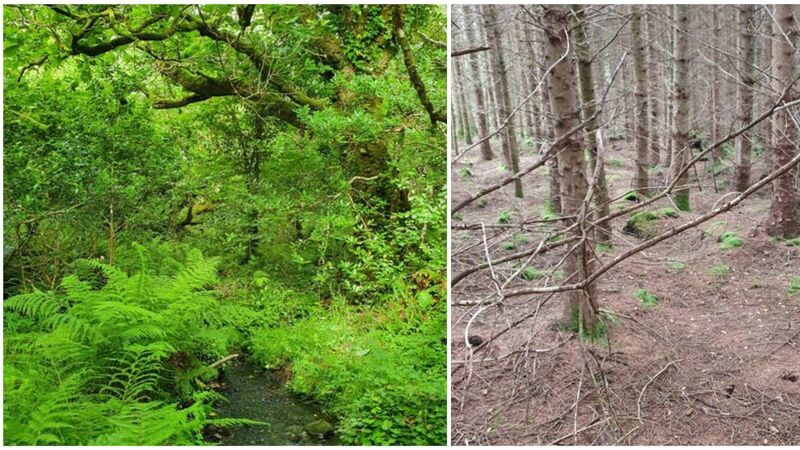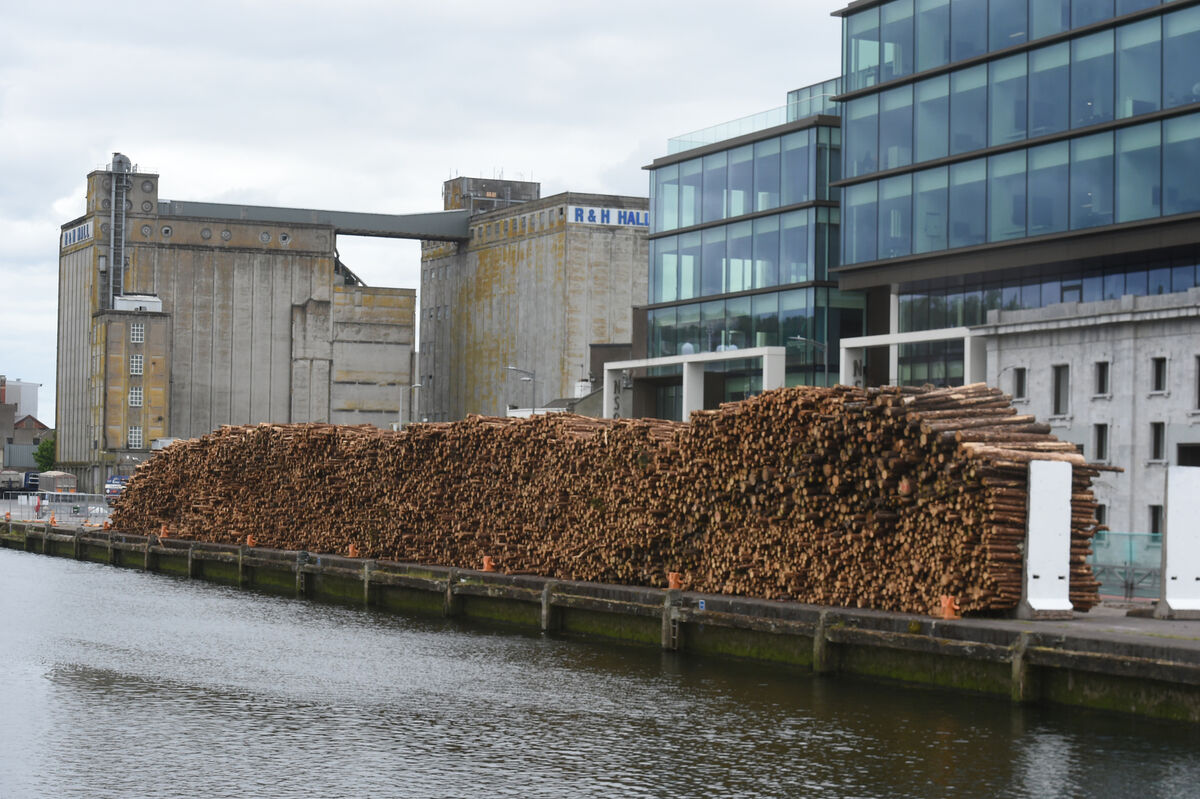Eoghan Daltun: Ireland's forestry policy needs a radical rethink — here's why and how

Left: Eoghan Daltun's native rainforest in Beara, West Cork. Right: sitka plantation for outdoors
Last week, the EU approved the Irish government’s Draft Forestry Plan, which aims to increase our level of ‘ woodland’ cover from 11 to 18% of land area. Given that the planet is in a dire climate and ecological crisis, this might appear wonderful news, but it’s actually the very opposite. Why?
Because the vast bulk of the trees envisaged will be non-native conifers and, like 90% of what we already have, these won’t be forests at all, but industrial plantation deadzones.
A genuine native forest isn’t just trees: it’s a highly complex ecosystem composed of thousands of species that evolved together over aeons: flowers, insects, birds, fungi, mammals, lichens, mosses, and much else. The fact that these species co-evolved means they developed all the interconnections that make everything work cohesively as an ecosystem. Walk in a healthy native forest, tragically very rare now in Ireland, and you’ll find yourself immersed in a living soup of buzzing insects, birdsong, and wildflowers. The fragment of temperate rainforest I’ve been restoring for 14 years in Beara, West Cork, is one such example.
🌿🌎 The European Commission approves afforestation measures in Ireland's €1.3 billion Forestry Programme 2023-2027https://t.co/S1OZred83v#ForestryProgramme #ClimateAction pic.twitter.com/iFgDPqDWhA
— Dept of Agriculture, Food and the Marine (@agriculture_ie) August 2, 2023
Now step from that verdant world, bursting with life, into a sitka spruce plantation — the most commonly planted timber crop in Ireland. The contrast could not be greater. You’ll see no wildflowers or insects, and hear no birdsong. It’s a dark, dead world, where all life has been driven out for one purpose: maximum productivity and profit.
Sitka is native to North America, and so doesn’t have ecological relationships with species on this side of the Atlantic. Equally problematically, it’s planted as a monoculture. A natural forest consists of a great diversity of tree species, and this is vital in making for rich wildlife habitat. A plantation of native ash, for example, isn’t much better than sitka, because the variety is lacking.
This is the dead nothingness that awaits vast areas of Ireland under the government's Draft Forestry Plan, just approved by the EU. Four years after the state declared a climate and ecological emergency. Do words have no meaning at all?
— Eoghan Daltun 🌍 (@IrishRainforest) August 3, 2023
We need to come together and *fight* this. https://t.co/KYs41eTAtx
Further, vast quantities of fertiliser and other chemicals are applied to make plantations grow faster, and to stop them from dying. This means water bodies are polluted by runoff, contributing to the crash in Ireland’s water purity. Yet any monoculture remains highly vulnerable to the sort of pests and diseases that are increasingly afflicting trees the world over due to the global plant trade, and climate breakdown. Every plantation therefore remains a disaster waiting to occur. Look, for example, at what happened with ash dieback: all over the country plantations have been wiped out. Across Europe, bark beetle is killing sitka, and the same threatens to happen here too.
Nor do plantations help in combating climate breakdown. In fact, they worsen it: the clear-felling and replanting operations release vast amounts of carbon from the soil, unlike actual forest ecosystems, which sequester and store atmospheric CO2 in great quantities. People living in the vicinity of plantations tell of a drastic loss in quality of life, as neighbouring family farms are replaced by desolate walls of light-excluding uniform dark green. Plantations are thus another driver of rural depopulation, and campaigns have been set up to push back against them in several counties.

Irish spruce is regarded poorly as a material, and many builders’ suppliers and contractors refuse it. Consequently, it’s largely used for such secondary purposes as making pallets, or paper pulp. So our current plantation forestry model is an utter disaster for nature, climate, and local communities, doesn’t produce a quality product, and is at constant high risk of collapse through mass die-off.
Yet we clearly need timber for a wide multitude of purposes, and ever more so as we urgently try to decarbonise our economy. Importing from abroad (as we currently do for much of our needs) isn’t the answer: we must become self-sufficient in homegrown alternatives without the negatives of the current model. Do these exist, and, if so, what are they?
Visit a clear-felled plantation and you’ll witness a scene of unparalleled destruction, the ground churned up by heavy machinery and strewn with piles of waste material. But look closer and you’ll generally see something very interesting: countless native tree seedlings: birch, willow, rowan, oak, and others. These are obliterated in the following planting cycle, but they could be let grow to maturity. It may come as a shock, but wild native trees are made of timber too, and could supply much of our needs. What would the advantages be?
First, they would create a natural ecosystem, benefiting nature, the climate, and rural communities. Because the trees seed-in naturally, planting operations are unnecessary and so the ground is left undisturbed, avoiding that great release of carbon. Since healthy native ecosystems help regulate the climate in far more ways than just drawing down carbon, they would help prevent climate breakdown, rather than adding to it, as plantations do. Genuine forests are pleasant environments for people too, making rural areas more attractive places to live, and boosting tourism.
Of course, they would take time to grow, but existing plantations could supply our timber needs in the meantime. The overall forested area would need to be enormously expanded, and some areas left untouched, but all that would be highly beneficial to nature and society. Continuous cover models should replace clear-cutting, and such time-honoured practices as coppicing looked at again. Hemp, which is many times more productive per acre, and other potential alternatives such as wood composites, should also be developed. In short, there are other options; we just need to get smart, and refuse to accept that vast swathes of our country must be ecologically sterile.
The forestry industry will cry that all this is wholly impractical, that everything is geared up to current production methods. But while 90% of Irish ‘forests’ are currently plantations, the European average is just 3%, and they seem to do just fine. Far more crucially, this is a time of catastrophic climate and ecological breakdown, and in very, very few countries globally is nature doing as badly as Ireland.
That, above all else, must determine the future of forestry in Ireland.
- Eoghan Daltun is author of . He is on Twitter and Instagram under @IrishRainforest







